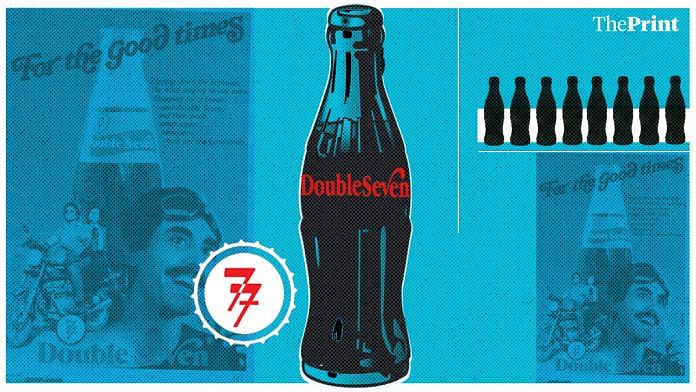Decades before Prime Minister Narendra Modi’s plan to Make in India, the country had tried to make its own ‘national’ cola. It was called Double Seven. The name came from the year it was launched – 1977.
Unofficially known as ‘sarkari cola’ or ‘satattar’, the drink was manufactured and marketed by the makers of Modern breads – Modern Food Industries – a government-owned company.
After the protectionist Janata government under Morarji Desai booted out Coca-Cola from the country, Double Seven was created to fill the void.
George Fernandes, then minister for industries, drafted a plan to develop a local cola brand assuming that Indians would take to it and the unemployed Coca-Cola workers would get jobs.
“The government is playing it cool, as well it might, with the prospect of the entire Rs 100-crore bottling business landing in its lap, complete with a country-wide production and marketing network of 22 bottling plants and over 200,000 retail outlets,” wrote India Today magazine in its September 1977 issue.
On 13 November 1977, the government started marketing Double Seven. While it promoted the drink as an alternative to Coca-Cola which has similar taste, colour, and flavour, most of the cola lovers did not agree to it.
Also read: Bollywood star on ads, Disneyland tickets, space-age branding & yet Thril cola fizzled out
Why Coca-Cola shut its business in India
Anti-Emergency crusader Morarji Desai’s Janata Party defeated Indira Gandhi’s Congress in 1977, after the Emergency.
It was the same year that Coca-Cola Export Corporation (CCEC) – Coca Cola’s Indian arm – reached out to Reserve Bank of India under the Foreign Exchange Regulation Act (FERA
Act) for permission to continue their business in India. The company went to the RBI for their quarterly requirement of import licenses, which were given by the Indian government for importing its ‘secret ingredient’ from the company’s headquarters in the US.
By this time, Coca-Cola had already been in India for about two decades. It was quite popular.
This ‘ingredient’ made just four per cent of soft drink’s total concentrate, but is known as the secret sauce behind its taste.
That year, under the new Desai government, the RBI ordered the CCEC to comply with FERA’s two provisions – to transfer 60 per cent of the equity shares to Indians and to fully transfer technical know-how to the Indian company.
Coca-Cola refused. It had to leave India.
“The officials handling the Coca-Cola case in the ministry give the impression that they would be happy to see the last of Coca-Cola,” India Today wrote while quoting another official in ministry saying, “One multinational less to deal with.”
Also read: Coca-Cola and PepsiCo agree on one thing – making sustainable drinks bottles
Making of Double Seven
The road to making an Indian cola was now clear. Desai’s party, to celebrate the year of their victory, named the cola ‘77’. But the name was already being used by a running, but unregistered soft drink, called “77”, manufactured by a Pune-based firm.
“The only person to have gained materially from the dispute (between Coca-Cola and the Indian government) so far is Hari Vishnu Kamath, the Janata MP, who has received a Rs 10,000 prize for suggesting the name Seven-Seven…,” India Today wrote.
After negotiations with the Pune-based firm, Modern Bakeries acquired the legal rights of the brand name and developed the concentrate for the drink.
The responsibility of developing concentrate for the drink was given to another government-run institution – Central Food and Technological Research Institute (CFTRI), Karnataka, Mysore.
Also read: ‘Livva little hot’ Rekha, a cola war and the zing thing: Remembering Gold Spot
Goodbye Double Seven
The drink faced tough competition from other popular drinks in the market including Campa Cola, Thums Up and Duke – all of which had also come about in the same time.
However, its taste failed to make an impact. “In my younger days, I was crazy about Coca-Cola. Despite repeated assurance from the government that Double Seven tastes like Coca Cola, we found no match. The fizz was much lesser, the taste of Double Seven was very sweet and the punch of drinking a cold-drink was missing,” said Anant Sharma, a 54-year-old government banking official in New Delhi.
Like Sharma, many Indians did not appreciate the taste of India’s local cola, due to which the venture failed to make healthy profits.
“March 1978 ended with a loss of Rs 3.87 lakh for the first half-year of operations. In March 1979, the expenditure had risen to Rs 39 lakh and profit to a measly Rs 93,000. By 1983, the government stopped giving out specific profit/loss figures for Double Seven,” according to a detailed post by a blogger, Pastmaster, on Medium.
However, the figures could not be verified independently.
Moreover, in 1979, Desai’s government collapsed, impacting the future of the brand even more.
In 1980, Indira Gandhi-led Congress came back to power. “Her government, while not against the brand, did not favour it like Desai’s government. The brand died a natural death after it failed to impress the audience and collect money for its sustenance,” said Santosh Sood, former chief operating officer of brand and ad-agency, Rediffusion Y&R.
In 1993, Coca-Cola was back in India in a big way. And the rest, as they say, is history.
Also read: Citra took humble nimbu paani & made it a soft drink Indians loved. Then Coca-Cola stepped in







Good morning, 77 used to be sold next to gold spot in bus stations, railway stations and other shops, being different from regular, we used to have 77, other competition was sprint also having cola taste, I remember Ms Rathi Agnihotri was with thril, it goes hum tum aur thril… Like that. Slowly and steadily coca-cola inavaded cool drinks market..
Being an Indian i m pleased and excited as our prime minister is working on Indian brand Ambani n, other giants should also plans on this. Thanks to modi government??✌✌